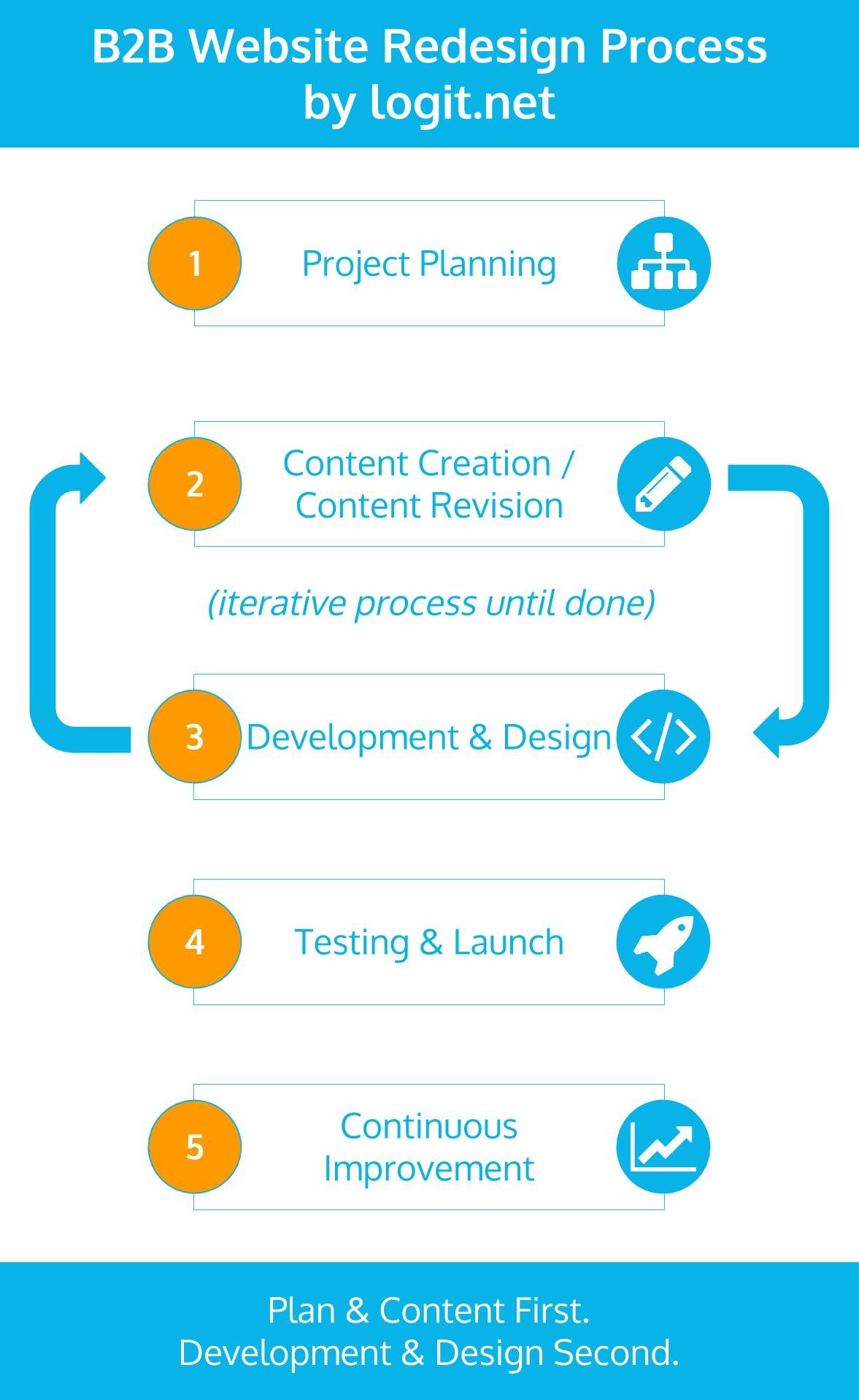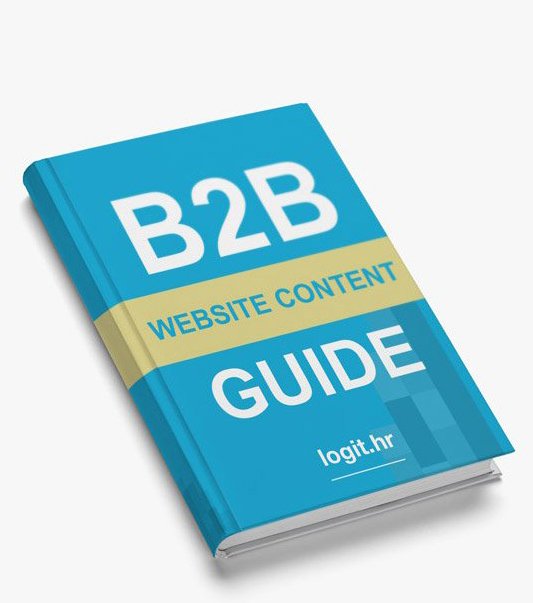Fitting content to design is like fitting the foot to the shoe. Sadly, that's how web design had developed historically. Even today, many web designers use the Design First approach to web development, and this causes trouble for everyone involved. Today, we introduce you to a more successful web development technique called Content First Approach. It's a website development process we use in Logit to save our clients time, money, and frustration.
Don't make this mistake: don't bury yourself in a never ending web development process. Uou can have it all go smoothly by using the Content First approach to web development.
The Trouble With the “Design First” Approach
In this approach, a website is being designed before website content has been written.
Years of experience in web development taught us that developing websites without real content never goes as expected. Numerous issues, arising from the flawed process itself, cause client dissatisfaction and loss of profits for the web design agency.
This is how the "Design First" approach usually looks like:
- Client signs the contract with the web design agency.
- Client pays the deposit.
- Designers begin working on the design without having any content, using the "lorem ipsum" placeholder content.
- Client likes and approves the design. Front-end and back-end development begins.
- The website is completed and the client signs off on it. Everyone's happy with each other.
- The empty website pages now await for the client to fill them with content.
In step 6, the client is expected to write the content (this process alone can sometimes take months or years) and deliver it to the agency.
This is where the troubles start.
Real Content Doesn’t Fit the Design
Some of the following may sound familiar to you:
- the designer did not make enough room for your longer-than-expected headlines
- the programmer did not implement the photo gallery for your photos
- your numerous product categories and subcategories look awful in a drop-down menu
- to look attractive, your product pages require more design elements that the designer created
- when you request changes, the agency requires that you pay for them (because you were happy with everything they delivered before, and even signed off on everything)
- there is a bunch of other unexpected difficulties.
Clients are, naturally, frustrated with such situations. This is where client-agency relationships often go sour.
Once two companies start blaming each other for not communicating the expectations well, it's very difficult to repair a broken business relationship.
A much better idea is to grab the web design process by its horns and never allow that it comes to this.
Experienced website development agencies have learned that a new approach to website development prevents most problems during a web design project.
Content First Approach Solves Various Website Development Problems
In Logit, we use the following website (re)design process. It has proven to produce the best results for us and our clients.

The project starts with the website planning phase. In that phase, website planning specialists work with the client on deciding all the important parameters related to content:
- which content types should be produced,
- in which formats should the content be published, and
- how much of every content type should be created.
Website content creation, web design, and web development are all part of one iterative cycle.
But content still comes before design and development.
The majority of the content needs to be written before web designers and web developers begin designing and coding the website.
The Content First approach usually looks like this:
- Client signs the contract
- Client pays the deposit
- The agency / content creation consultancy works with the client on content planning and creation
- Client writes and delivers something we call "minimum viable content": the minimum amount of content for every different content type
- The web development process unfolds and iterates in the following cycles: 1) back-end development, 2) entering the content, 3) web design, 4) front-end development.
The "Minimum Viable Content" Concept
Let's say that you want a simple website that would consist of the following pages:
- homepage
- products (20 products)
- services (5 services)
- clients (30 clients)
- about
- contact
To get started with website design and development, there's no need to wait until you can create content for 20 products, 5 services, and 30 clients. At minimum, you should create real examples of every different content type, such as:
- at least one real product
- at least one real service
- at least one real client
- the entire "About Us" page content
- the entire "Contact Us" page content
Working on that content will force you to think about which data and which information you should write to present your products, services, clients, and your company well.
This way, you reduce the chance that you'll forget to include a major piece of information, such as product brochure downloads on a product detail page.
If you (or someone you hired to create content for you) do the thinking before the designer does the designing, you reduce the chance that your content won't fit the design you approved and signed off on. It's impossible for a designer to come up with a quality design for content of unknown scope and type.
Benefits of Content First Approach to Website Development
- your website (re)design project will be delivered on time,
- you don’t have to pay more than it has been agreed in the contract because the designer doesn’t have to make any major changes,
- there are no nasty surprises along the way or 2 days before the website is to be launched,
- minor changes can be made without paying a hefty sum, without breaking the website, without delaying the website launch,
- you'll enjoy a long and productive relationship with your chosen website professionals, who will respect you back and treat you the way you deserve to be treated.
Most Clients Need Help With Writing Content for Their Website. Do You?
We've been in the digital marketing industry since 2000. The number one problem our clients had with their websites was always one and the same:
delivering website content on time.
Sometimes, it took our clients years to create all the content. Waiting for months was the norm.
We completely understand and know why this is happening:
- You are busy with your everyday tasks which simply must be done.
- Writing website content is not your core competency (there are no copywriters in a typical B2B company).
- You don't know what is important to write about.
- Content creation as a service is rare, because most web development agencies only offer design, programming, and internet marketing services - not copywriting.
- Content creation is hard, because it takes at least one subject matter expert within your company to create content. Subject matter experts are usually the busiest people: company owners, directors of marketing, directors of sales, CEOs of small businesses, etc.
- Because professional copywriting services are costly, companies such as yours usually choose to produce content on their own.
A Solution in the Form of a Website Content Creation Guide
Check out our B2B Website Content Guide product:
Download a Free Sample of the Guide1.7MB PDF, no registration requiredWith this guide, you won't postpone writing content for months or years because the guide will tell you exactly what to write about. This way, you'll launch your website sooner and this website will make you money by attracting new customer inquiries. By waiting, you could be losing thousands of euros annually on lost profits.
The guide is a 70-page digital download containing dozens and dozens of smart questions that professionals in Logit use to create content for our clients and our own websites. Instead of figuring out from scratch what is important to write about, save dozens of hours pondering about content. Simply answer our questions and your answers become your content. Now you can focus on your real work.
For example, Logit has used the questions in this guide to write awesome content in only 2 weeks, for a client in a highly technical industry we knew nothing about. Read more in the itd.systems case study.
Are You The Boss? Save Countless Hours of Work
If you have to write your own website content because you're the subject matter expert - and you're one of the busiest people in your company - we recommend you do this:
- order and instantly download the B2B Website Content Guide
- give the Guide to one of your employees (select one who knows the basics of business communication, i.e. how to write a solid email to a customer)
- have the employee ask you the questions from the Guide to interview you: you simply answer their questions
- have the employee record your live interviews, using inexpensive hardware such as a smartphone or a microphone on their computer (alternatively, invest in a solid, inexpensive dictaphone)
- have the employee transcribe audio interviews to written digital content, or outsource this task to low-cost freelancers on odesk.com
- have the employee organize the transcribed content in Word documents (one website page = one Word document)
- have the employee edit, improve, and finalize the transcribed content, if he/she is skilled enough. You can always hire content writing specialists for this editing part (which is when good content gets created).
- have the employee use the folders structure you get with our Guide, to organize Word documents well
- have the employee gather and add images and downloads and files to folders
- have the employee zip the folders in one .ZIP file and send it to the website development agency
- done!
Notice how, out of 10 steps, you're personally involved only in the first 3 steps, and you're expected to invest a couple of hours in step 3 (when someone else interviews you). While you may be the only person who knows everything about your company, the content creation process consists of many other necessary steps that others can work on.
In our experience with writing other people's content, this process saves 9 hours for every 1 hour a Very.Important.Person spends giving an interview.

